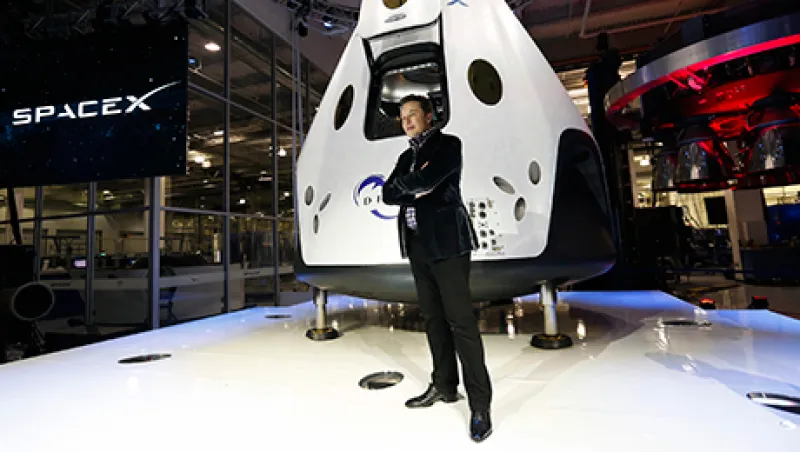On June 27, NASA reported that the Curiosity Mars rover had found vestiges of atmospheric oxygen while exploring the red planet’s sandy terrain. This, in addition to the recent discovery of what may have been an ancient lake on Mars, is good news for SpaceX founder and CEO Elon Musk, who wants to start building a colony there as early as 2018. When Musk unveils more details about these plans at a September aeronautics conference in Mexico, they will likely make for exciting headlines but leave most observers wondering what’s in it for them. Thus far the space industry has been largely the domain of governments and billionaires, such as Musk, Amazon.com founder and CEO Jeffrey Bezos and Virgin Group’s Richard Branson. While these men and their companies may have the spotlight, experts say they represent only a small part of the space sector’s investable universe.
That universe has expanded significantly in recent years. The space industry’s annual revenue grew nearly 9 percent in 2014, to $329 billion, according to the Colorado Springs–based nonprofit Space Foundation. Although the sector — which includes manufacturing, rocket launches, satellite construction and operation, and consumer services — experienced a decline in 2015, falling to $323 billion in total revenue, the Space Foundation attributes the drop to a strong U.S. dollar and expects continued growth in the future. As the number of players increases, so does the amount of innovation, and a new space race has begun. The story in the 1950s and 1960s was about whether the U.S. or the USSR would get to the moon first; today’s competition focuses on reusability, efficiency and lower costs.
Thanks to a shrinking U.S. federal space budget and exponential technological innovation, private companies are making major strides in space. Equipment that once cost billions of dollars to manufacture can now be made for millions or, in the case of some satellites, hundreds of thousands.
Blue Origin, a Kent, Washington–based aerospace manufacturer founded by Bezos, and Musk’s SpaceX this year became the first privately held companies to land rockets successfully back on Earth after a launch. They are now pioneering efforts to commercialize reusable rockets.
Progress is being made in satellites as well. San Francisco–based Earth imaging start-up Planet Labs designs miniature satellites, known as Doves, that weigh about nine pounds, some 1,000 times less than a typical commercial satellite. Released in “flocks” into low Earth orbit, they can be used by telecommunications, agriculture and security companies for a variety of tasks and services.
“Some creative destruction is already taking place,” says Claire Jolly, head of the OECD Space Forum. “Will that revolutionize the entire space sector short-term? Probably not. But we are seeing the premises of a new paradigm, with a growing part for private actors and investors.”
Investors don’t have to be billionaires or venture capitalists to take part in the current space race. A new index created by Cambridge, Massachusetts–based Kensho Technologies offers a detailed look at 40 businesses that are poised to provide the parts, technologies, services and software to start-ups like SpaceX, Planet Labs, their peers and their yet-to-be-founded successors.
“When people think about space, they think SpaceX and Elon Musk,” says Kensho CEO Daniel Nadler. “They don’t think about air products, companies manufacturing hoses. This index represents not just an important area of the new economy but a mental shift in how people think about where that new economy is located.”
The index uses natural language processing algorithms to comb financial statements and find out which publicly traded companies have exposure to the space industry. In some cases the relevant exposure is buried deep in regulatory filings that would be infeasible to search without the algorithm, says Nadler. The Space Index includes aerospace and defense stalwarts such as Lockheed Martin Corp. and Raytheon, as well as integrated-circuit manufacturer Linear Technology Corp. and fiber optics connector producer Amphenol Corp. “The popular image is that [the space sector] is all a bunch of privately held, non–publicly traded companies,” says Nadler. “The index really illustrates that there is an investable dimension of even the most futuristic parts of the new economy.” Kensho’s Space Index is up nearly 7 percent over the past 12 months and more than 60 percent over the past three years.
When it comes to space, the U.S. government still has a major role, but its focus has shifted. While NASA works on moving farther into deep space and finding a way to land on asteroids, members of the new space economy are more interested in collecting data, providing cheaper communications technology and launching rockets.
Both NASA and Musk are trying to get to Mars. Although SpaceX is arguably more nimble than the government agency, the Hawthorne, California–based company has some bugs to work out. On June 15, a few months after successfully landing a Falcon 9 rocket on a floating drone ship, SpaceX sent it up again, inviting the public and press to watch via webcam. The rocket launched two satellites without incident — one that would provide telecommunications services for public and private clients in Latin America and the other to be used by the Federal Aviation Administration — and the excitement at SpaceX headquarters was palpable, even through the screen. But when it came time to return to Earth, the Falcon 9 appeared to make a hard landing. Smoke filled the screen, and the feed broke up, anxious shouts from the crew at SpaceX erupting whenever the image briefly returned. Later, Musk tweeted that the rocket had crashed. He wasn’t deterred, predicting the next flight would have a better chance of success.
“Unlike the public sector, the commercial sector is okay with failure,” says Kristine Liwag, vice president of aerospace and defense equity research at Bank of America Merrill Lynch in New York. “It’s how they get better and learn.”
In the meantime, companies like the ones in Kensho’s Space Index will keep producing parts for current and future missions.
Follow Kaitlin Ugolik on Twitter at @kaitlinugolik.






